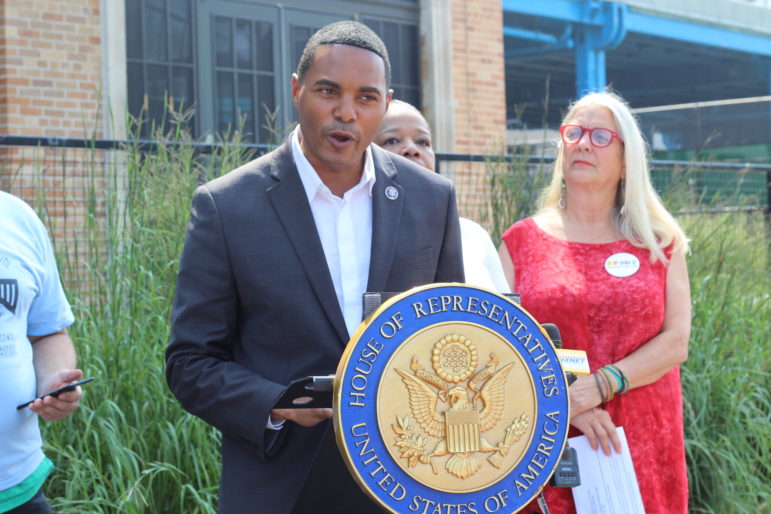A representative for the companies behind the proposal say they’ve since agreed to revise the plans in response to the community opposition, and if the project is approved, would build the converter in an industrial area outside of the Bronx.

Liz Donovan
U.S. House Representative Ritchie Torres announcing a deal about the proposed converter.For the past several months, South Bronx residents have been bristling at a proposal that would build a high-voltage converter station in their neighborhood—what the project’s leaders say would bring renewable resources to New York City, but which community members felt would mean risking their health in the name of green energy.
On Wednesday U.S. House Representative Ritchie Torres, who represents the pollution-plagued Bronx district, announced he had stepped in and negotiated a compromise, getting the project’s leaders to agree to build the converter in a non-residential area if it’s ultimately approved by the state.
A representative for the companies behind the proposal confirmed to City Limits that they’ve since agreed to revise the plans in response to the community opposition, and if the project is approved, would build the converter in an industrial area outside of the Bronx.
“We all support the goal of clean energy,” Torres said at a press conference Wednesday announcing the agreement.
“Having said that, the ends do not justify the means,” he added. “We cannot perpetuate environmental racism in the name of environmental protection. We cannot allow the South Bronx to bear the burden of a green energy revolution while everyone else enjoys the benefits.”
In May, Clean Path New York—a joint venture comprising the New York Power Authority, energyRe and Invenergy—submitted the 317-page proposal to the New York State Energy Research and Development Authority (NYSERDA) in response to solicitations for projects bringing renewable energy into the city.
The project encompasses a 1,300 megawatt, 176-mile high-voltage direct current power superhighway from Delaware County to New York City, running underneath the Hudson and Harlem rivers. It would also deliver 3,800 megawatts of wind and solar power upstate, the proposal says.
Clean Path NY boasts that it would deliver $12 billion in savings to New Yorkers and create more than 10,000 jobs while eliminating 39 million tons of CO2 emissions over the next 25 years. It would also invest $70 million in environmental justice programs, and the project would lead to billions in health savings in vulnerable communities across the state over the next two and half decades, the proposal says.
But Bronx residents and organizers were shocked when they read the fine details. The project would place a high-voltage converter station—which some studies suggest may pose a health risk—and seven-story containment structure on a one-acre site at Bronx Terminal Market.
The area is already plagued with major polluters, like peaker plants, waste transfer stations and natural gas plants, leading to health effects that earned the area the nickname “asthma alley.”
Melissa Barber, co-founder of nonprofit South Bronx Unite, said she was enraged when she saw the proposal. “In the name of renewable energy you’re about to screw us over once again as an environmental justice community,” she said. “It never ends.”
The proposed location for the station, which would start operation in 2026 if it moves forward, would have been in a densely populated residential area near the Mill Pond Park, multiple schools, new housing developments, a family shelter and the Bronx Children’s Museum, which is completing construction nearby on a new facility.
The museum published a statement in July about their concerns with the project and its proximity to areas where community and children regularly gather.
“We believe the station poses an environmental justice threat and is yet another example of how the South Bronx and communities of color are disproportionately harmed by systemic racism,” it said. “In addition, the siting of a high-voltage converter station and any high-voltage AC transmission lines are likely to cause harm on multiple levels to such a robust community.”
Last month, the Bronx Institute for Urban Systems also released a 20-page report criticizing the proposal and citing multiple studies conducted in the United States and United Kingdom linking exposure to electromagnetic fields and high-voltage AC transmission lines to childhood cancer clusters.
“Any ongoing exposure to electromagnetic fields and high voltage infrastructure in a dense urban environment should be considered an undue burden and potential public health threat,” the report concluded.
“They put out an RFP [request for proposal] and didn’t ask anyone in the community if this is what we wanted and if we agreed to it,” said Barber.
When questioned about the project, NYSERDA responded that its “evaluation process prioritizes consideration of projects that bring the highest and best value to New York State, including evaluation criteria during the selection process explicitly valuing the interests of disadvantaged communities, and economic benefits, in New York.”
NYSERDA’s website says it received bids for seven projects in response to the RFP, including the one from Clean Path New York. The chosen bids will be awarded by the third quarter of 2021, which ends at the end of September, according to the agency’s timeline.
On Wednesday morning, Torres announced he’d secured the written commitment from the companies behind the proposal, which City Limits has obtained, agreeing to put the station in a non-residential area.
“I made it crystal clear that under no circumstance would I allow for the siting of high-voltage infrastructure in a residential neighborhood, especially one as densely populated as Mott Haven because nothing is more important than the public health of Bronx residents, particularly children,” he told City Limits.
“To the credit of the applicant, the applicant agreed,” he added.
In a statement, the applicants behind the project said they pride themselves, “on listening to and working with the community.”
“Clean Path NY is committed to locating an HVDC converter station—a piece of green infrastructure with zero emissions—only in an industrial area,” a spokesperson for the three companies said. “Clean Path NY presents a transformative environmental justice opportunity for the people of the Bronx by delivering clean, renewable energy generated upstate to the borough.”
Carla Precht, executive director of the Bronx Children’s Museum, said the agreement marks a shift for the Bronx community, which has long has to shoulder a disproportionate burden of the state’s energy infrastructure.
“This signals for the South Bronx a new day because we’ll no longer be a dumping ground,” she said.
The New York Power Authority currently operates six so-called “peaker” plants in New York City, including in Mott Haven and Port Morris. These fossil fuel-fired plants were installed in 2001 and are intended for use only intermittently, at times of peak electricity demand, according to the NYPA. They’re also widely criticized by environmental advocates for the high levels of harmful carbon dioxide and nitrogen oxide they emit.
In 2020, after the passage of the Climate and Community Leadership Act, the statewide progressive climate legislation that called for zero-carbon emission by 2040, the NYPA worked with environmental justice advocacy groups to assess how it could transition the peaker plants to clean energy. But as of August 2021, they are still in service.
Barber questioned the plans of the company going forward.
“Does this mean that because you’re getting into renewable energy,” she asked, “are you now closing the peaker plants that are here?”
Liz Donovan is a Report for America corps member.










2 thoughts on “Rep. Ritchie Torres Strikes Deal to Keep Proposed High-Voltage Converter Out of South Bronx’s ‘Asthma Alley’”
Unfortunately, the City Limits story is inaccurate. It says that Ritchie Torres struck a deal so that the power plant is located outside of the Bronx. That is not true. Torres struck a deal to keep the power plant away from the Children’s museum, but the power plant never said it would take it outside the Bronx. Torres said that he got the power company to agree not to place the high voltage gear in a residential neighborhood, but they are not allowed to do that by law anyway.
Hi Steven — Clean Path New York representatives told City Limits directly that the converter will not be in the Bronx.